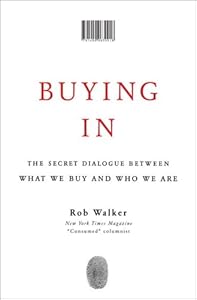I heard Rob Walker on some podcast recently telling some of the anecdotes from his 2008 book Buying In: The Secret Dialogue Between What We Buy and Who We Are and snagged it from the Santa Fe Public Library. I've been picking at it for a couple of nights, and I'm 154 pages in with about 110 pages to go.
It would be unkind to refer to Walker as a poor man's Malcolm Gladwell, but given that he's working in a similar style (a single glimmering image with a lot of surrounding social science) and references Gladwell's New Yorker article The Coolhunt, the comparison is probably inevitable.
Buying In is more a discussion of the complicated interaction between consumers and the advertisers who attempt to sell things to them; it isn't really about buying, and it isn't really about identity. It's really about brand and its appropriation.
That being said there are some neat little nuggets in this book: Walker revisits the inner city Timberland phenomenon, discusses the fate of Pabst Blue Ribbon, explains how Gucci logos appeared on the cover of Eric B. & Rakim's album Paid In Full, and parses the meaning of Converse sneakers now that Nike owns Converse.
Particularly interesting is the fate of Pabst, Schlitz, Carling Black Label, Falstaff, Olympia, Stroh's, Lone Star, Rainier, Old Style, Colt 45, and St. Ides: all these cheap formerly regional taste-alike beers and malt liquors are owned by the same company due to the efforts of one Paul Kalmanovitz, who bought them all up, cut costs (including headcount), with a plan not to revive them or consolidate them or whatever, but to let them "decline profitably." It's real bottom-feeding end-state capitalism.
But Walker is obsessed with energy drink Red Bull in particular: how it sells itself with vaguely sexual messages (no, he hasn't touched on its popularity in gay bars yet), its creation story and market rollout, and especially on a nearly unreported publicity stunt involving kiteboarders traveling from South Florida to Cuba in December 2001. And that leads Walker to his one interesting insight so far: where some people think of themselves as message-savvy and commercial-immune, others willingly sell out. The Portland PBR crowd strains to fit into the former category, as do contemporary hipster Converse wearers, while the Red Bull kiteboarders, Tylenol-sponsored professional gamers, etc. fall into the latter.
Walker clutters his book by trying to make it high-concept (his "Desire Code" and "murketing" still haven't come into focus), and the net result so far is a book that swings and misses: some great paragraphs submerged in thoroughly skimmable chapters.
exercises in compound storytelling
Subscribe to:
Post Comments (Atom)

![Reblog this post [with Zemanta]](http://img.zemanta.com/reblog_e.png?x-id=5ceb01a1-d1cd-4dcf-8fb0-34ab89d72466)

No comments:
Post a Comment